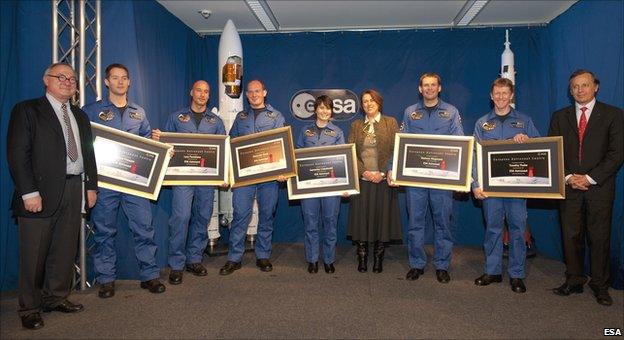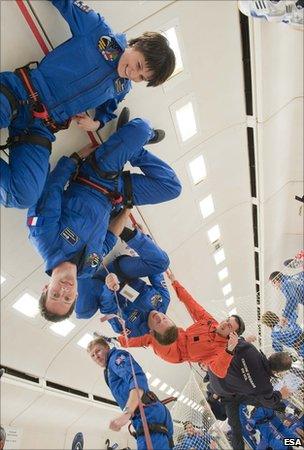Europe's new astronauts graduate
- Published

The six must now wait their turn to get an opportunity to go into space
The European Space Agency's (Esa) new intake of astronauts have completed their basic training.
The six individuals - two Italians, a German, a Frenchman, a Dane and a Briton - received their graduation certificates at a special ceremony in Cologne, Germany.
They are the first group of candidates Esa has put through a training programme of its own design.
Previous astronauts have relied on the US and Russia for their education.
Alexander Gerst, Samantha Cristoforetti, Thomas Pesquet, Andreas Mogensen, Luca Parmitano and Timothy Peake will now be given a range of duties within the agency.
"It's been a real whirlwind, a fantastic experience," said Major Peake, a former helicopter pilot with the British Army Air Corps.

Training included a microgravity simulation flight
"We now have to wait for our chance to fly in space but there are some great jobs to be doing in the meantime," he told BBC News.
The first chance for one of the new recruits to go into orbit to visit the space station should come in 2013.
This is expected to be one of the two Italian fighter pilots in the group - Samantha Cristoforetti and Luca Parmitano.
The 2013 opportunity is guaranteed under an agreement the Italian Space Agency (Asi) has bartered for its nationals in exchange for producing key modules for the space station.
Esa itself can nominate another individual for the following year, with a further Asi flight guaranteed in 2015.
"Without going into the names and the specifics of who might be assigned to a particular flight, what I can say today is that 50% of the new astronauts are already in a good position to fly by 2015," Simonetta Di Pippo, Esa's director of human spaceflight, told BBC News.
"We will make the sequence public for the first three flights in the coming weeks."
The new recruits were selected in May 2009 and began their training in the September of that year.
Activities have included Russian language lessons, engineering familiarisation; and medical, survival and robotics training. The sextet have also experienced what it is like to operate in the weightless environment of space by flying on a jet that simulates microgravity conditions.
This was followed up by sessions in a large pool that tries to reproduce the sensation of spacewalking.
.jpg)
Major Tim Peake in the Neutral Buoyancy Facility at Esa's training centre
Future work will include a stint as Eurocom - the ground controller who talks to astronauts on the ISS as they perform experiments in Europe's Columbus science laboratory.
"The training from now on will be much more individualised," said Dane Andreas Mogensen.
"For me personally, in the New Year I will start some pilot training to get my pilot's licence. And then there will be other advanced training, for example more EVA (spacewalking) training at Nasa in Houston and more robotics training in Canada."
Flight opportunities for astronauts from all the partner space agencies on the ISS will be restricted in the next five years because the US is retiring its seven-seat shuttles.
The only way to get into orbit from next year will be on Russian Soyuz vehicles. These can carry just three individuals at a time.
America hopes to introduce a number of commercial crew taxi services from mid-decade onwards.
Recently, the ISS partners agreed to extend the life of the space station until at least 2020. European Space Agency member states are expected to formally endorse that decision at a council meeting in December.